Music Library: John Coltrane and The Seven Samurai
I'm kidding, of course, about the Seven Samurai. But there is something of Akira Kurosawa in Coltrane, I think. As Kurosawa was the post-War Japanese director most accessible to Western audiences, John Coltrane is the most accessible post-bop/free-jazz musician to audiences unattuned to the demands of jazz upon a listener. Kurosawa was not a director given to compromising his vision, but his tendency to pull ideas and imagery from popular genres such as the Western and popular directors such as John Ford contibuted to the timeless appeal of his movies that allowed his own ideas and imagery to cross back over into Western cinema. It's hard to imagine, for instance, where Peckinpah, Coppola, Spielberg, and George Lucas, for instance, would have been without Kurosawa. Coltrane's style - the sheets of sound, the honking overblown horns, the endless modal improvisation - was similarly uncompromising. But Coltrane also used pop music and the blues to give listeners a road-map through his sound, and Coltrane's passionate rapid-fire sax translated surprisingly well to psychedelic rock of the late 60s and afterwards, contributing to the very idea of an expansive guitar solo. As Kurosawa led to the epics of the late 60s and pop genre-smashing of the 70s, Coltrane begat Jimi Hendrix and Tom Verlaine. Not to mention most anyone playing jazz associated with the high period of Modern Jazz.
I read a biography of Coltrane many years ago, most of which I've forgotten. But what sticks with me is that Coltrane was a pretty boring guy. Outside of his apprenticeship with other musicians and almost-obligatory heroin addiction and recovery, Coltrane appears to have been a man who disappeared into his music. He practiced, recorded, and toured. He held complicated religious beliefs, but anyone who listens to his music can hear that. He assembled the tightest quartet in jazz and rode them as far as they could go. And then he went on for a couple of more years before he very suddenly died. His story is almost archetypical, a jazz version of Icarus. Kurosawa survived his fall from grace for a few more decades, and even got to make a handful of movies after his heyday. Coltrane didn't. I don't know which is worse. I mean, to be the person living the life, it's certainly better to survive. But to be the legend: well, I don't know.
There's a lot of early (pre-1960, that is) Coltrane albums on Prestige. Most were not originally attributed to Coltrane, but after his fame grew, Prestige rechristened them for the man. Most are also pretty decent albums, if not as revelatory as the albums after he came into his own.
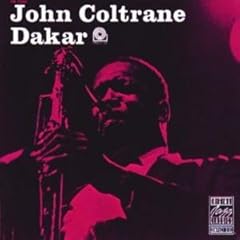 Dakar (April 1957). This one is a hard bop album that stands out from the standard hard bop of the late 50s by virtue of the interplay between Coltrane and the other saxophonists Cecil Payne and Pepper Adams.
Dakar (April 1957). This one is a hard bop album that stands out from the standard hard bop of the late 50s by virtue of the interplay between Coltrane and the other saxophonists Cecil Payne and Pepper Adams. Traneing In (Aug 1957). The Red Garland Trio is the aforementioned Mr. Garland on piano, Paul "Mr. P.C." Chambers on bass, and Art Taylor on drums. Another top-notch hard bop album.
Traneing In (Aug 1957). The Red Garland Trio is the aforementioned Mr. Garland on piano, Paul "Mr. P.C." Chambers on bass, and Art Taylor on drums. Another top-notch hard bop album. Blue Train (Sept 1957). My version of this album is actually called The Ultimate Blue Train, but I have my doubts about how seriously Blue Note is using the word "ultimate." I suspect that at some point new material will surface and then there will be a version of Blue Train that is somehow more ultimate, marking mine as the Penultimate Blue Train. Anyway, this is Coltrane's first real date as a bandleader, as well as his only album for the Blue Note label. Four of the five tracks were written by Coltrane, and it marks the first appearance of the "Coltrane changes," which are an approach to the structure of a song that have become a standard Mendoza line for jazz musicians to master. This album would be a career-level high for most musicians, but for Coltrane, it's barely the beginning.
Blue Train (Sept 1957). My version of this album is actually called The Ultimate Blue Train, but I have my doubts about how seriously Blue Note is using the word "ultimate." I suspect that at some point new material will surface and then there will be a version of Blue Train that is somehow more ultimate, marking mine as the Penultimate Blue Train. Anyway, this is Coltrane's first real date as a bandleader, as well as his only album for the Blue Note label. Four of the five tracks were written by Coltrane, and it marks the first appearance of the "Coltrane changes," which are an approach to the structure of a song that have become a standard Mendoza line for jazz musicians to master. This album would be a career-level high for most musicians, but for Coltrane, it's barely the beginning.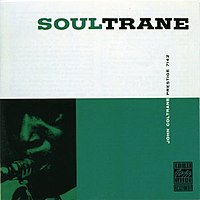 Soultrane (Feb 1958). Yet another date with the Red Garland trio. As with Traneing In, this is excellent hard bop.
Soultrane (Feb 1958). Yet another date with the Red Garland trio. As with Traneing In, this is excellent hard bop.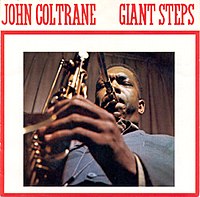 Giant Steps (1960, recorded Apr-Dec 1959).Only three weeks after Coltrane and Miles Davis knocked out Kind Of Blue (oh, you've heard of it?), Coltrane revolutionized bebop with this album. And then he quit bebop altogether. As Lindsay Planer writes on Allmusic, "The resolute intensity of 'Countdown' does more to modernize jazz in 141 seconds than many artists do in their entire careers." Yeah, that. Every song is a classic. Every performance is amazing. And this is only Coltrane's second album as a bandleader.
Giant Steps (1960, recorded Apr-Dec 1959).Only three weeks after Coltrane and Miles Davis knocked out Kind Of Blue (oh, you've heard of it?), Coltrane revolutionized bebop with this album. And then he quit bebop altogether. As Lindsay Planer writes on Allmusic, "The resolute intensity of 'Countdown' does more to modernize jazz in 141 seconds than many artists do in their entire careers." Yeah, that. Every song is a classic. Every performance is amazing. And this is only Coltrane's second album as a bandleader. The Avant-Garde (with Don Cherry, recorded June-July 1960). This one was unreleased until 1967. It's a strange one, too, with Coltrane co-leading a band with Don Cherry, who was mostly known as Ornette Coleman's trumpeter/cornetist at the time. And the band is basically Coleman's band, with Ed Blackwell on drums and Charlie Haden on bass for two tracks, switching out with Percy Heath on bass for the other three. Three Coleman compositions, one by Cherry, and Monk's "Bemsha Swing." And Coltrane and Cherry aren't bad together, but they don't gel like Coleman and Cherry do.
The Avant-Garde (with Don Cherry, recorded June-July 1960). This one was unreleased until 1967. It's a strange one, too, with Coltrane co-leading a band with Don Cherry, who was mostly known as Ornette Coleman's trumpeter/cornetist at the time. And the band is basically Coleman's band, with Ed Blackwell on drums and Charlie Haden on bass for two tracks, switching out with Percy Heath on bass for the other three. Three Coleman compositions, one by Cherry, and Monk's "Bemsha Swing." And Coltrane and Cherry aren't bad together, but they don't gel like Coleman and Cherry do.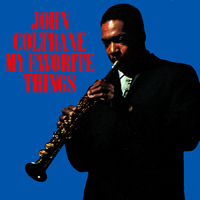 My Favorite Things (1961, recorded October 1960). So Coltrane went modal, meaning that these songs are mostly given over to epic soloing with minimalist (and yet vital) accompaniment. Four tracks, including the Sound of Music title track and a reworking of "Summertime." It's not just one of the most popular jazz albums of all time, but one of my favorite albums. I first heard it when I was 21 or so, and suddenly jazz made sense to me. That was a few years before I heard Richard Thompson play, but I think he mentioned at my very first RT show how much influence McCoy Tyner's fractured piano style had on his approach to the guitar. Oh, which reminds me that I should mention that the band on this album includes most of his classic quartet: McCoy Tyner on piano and Elvin Jones on drums. The bassist was Steve Davis, though, rather than Jimmy Garrison.
My Favorite Things (1961, recorded October 1960). So Coltrane went modal, meaning that these songs are mostly given over to epic soloing with minimalist (and yet vital) accompaniment. Four tracks, including the Sound of Music title track and a reworking of "Summertime." It's not just one of the most popular jazz albums of all time, but one of my favorite albums. I first heard it when I was 21 or so, and suddenly jazz made sense to me. That was a few years before I heard Richard Thompson play, but I think he mentioned at my very first RT show how much influence McCoy Tyner's fractured piano style had on his approach to the guitar. Oh, which reminds me that I should mention that the band on this album includes most of his classic quartet: McCoy Tyner on piano and Elvin Jones on drums. The bassist was Steve Davis, though, rather than Jimmy Garrison. The Complete Africa/Brass Sessions (May-June 1961). Coltrane's first album for Impulse! is another departure (what do you call it when all an artist does departures?) of sorts: a big-band album. Coltrane has Tyner and Jones, along with bassists Reggie Workman and Art Davis, who at the time were both part of Coltrane's regular quintet. But there's also a 15-piece brass section that includes Eric Dolphy, Freddie Hubbard, and Booker Little. Although these tracks were originally released on two separate albums, my copy is the Complete Africa/Brass Sessions, which moves the track order around and adds two tracks. I frankly love the hell out of the versions of "Greensleeves" herein, which are funky, ominous, and utterly amazing.
The Complete Africa/Brass Sessions (May-June 1961). Coltrane's first album for Impulse! is another departure (what do you call it when all an artist does departures?) of sorts: a big-band album. Coltrane has Tyner and Jones, along with bassists Reggie Workman and Art Davis, who at the time were both part of Coltrane's regular quintet. But there's also a 15-piece brass section that includes Eric Dolphy, Freddie Hubbard, and Booker Little. Although these tracks were originally released on two separate albums, my copy is the Complete Africa/Brass Sessions, which moves the track order around and adds two tracks. I frankly love the hell out of the versions of "Greensleeves" herein, which are funky, ominous, and utterly amazing. The Complete 1961 Village Vanguard Recordings (Nov 1961). Captures three days of the quintet (Coltrane, Dolphy, Tyner, Workman, and Jones) live at the Village Vanguard (with four more musicians occasionally cropping up, including Jimmy Garrison on bass and Roy Haynes on drums). The orignal release was Live! At the Village Vanguard, but I was lucky enough to get a copy of this four-disc box set from a friend a few years back. Outstanding music.
The Complete 1961 Village Vanguard Recordings (Nov 1961). Captures three days of the quintet (Coltrane, Dolphy, Tyner, Workman, and Jones) live at the Village Vanguard (with four more musicians occasionally cropping up, including Jimmy Garrison on bass and Roy Haynes on drums). The orignal release was Live! At the Village Vanguard, but I was lucky enough to get a copy of this four-disc box set from a friend a few years back. Outstanding music. Duke Ellington and John Coltrane (Sept 1962). Ellington replaced Tyner in Coltrane's quartet for three of these tracks and then replaced Garrison and Jones with two of his own guys on four other tracks. It's lovely to hear these two guys working together, even if it fails to achieve the heights of the similar Money Jungle, which Ellington made with Charles Mingus and Max Roach.
Duke Ellington and John Coltrane (Sept 1962). Ellington replaced Tyner in Coltrane's quartet for three of these tracks and then replaced Garrison and Jones with two of his own guys on four other tracks. It's lovely to hear these two guys working together, even if it fails to achieve the heights of the similar Money Jungle, which Ellington made with Charles Mingus and Max Roach.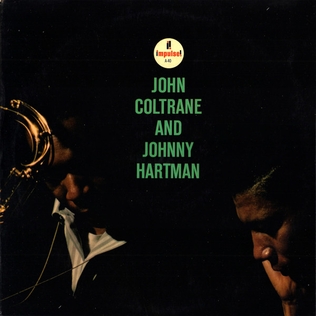 John Coltrane and Johnny Hartman (Mar 1963). There's no logical reason for why this album works so well. Johnny Hartman is a jazzy pop singer in the style of Nat King Cole (I'll get to the album I have of his in a week or two), but here he and the classic quartet mesh so amazingly that it's hard to describe music this transcendental. They stick to ballads, and the result is, well, perfect. A word of caution: listening to this album in the proximity of a romantic interest may result in pregnancy without proper protection.
John Coltrane and Johnny Hartman (Mar 1963). There's no logical reason for why this album works so well. Johnny Hartman is a jazzy pop singer in the style of Nat King Cole (I'll get to the album I have of his in a week or two), but here he and the classic quartet mesh so amazingly that it's hard to describe music this transcendental. They stick to ballads, and the result is, well, perfect. A word of caution: listening to this album in the proximity of a romantic interest may result in pregnancy without proper protection. Impressions (1963, recorded Nov 1961 and Apr 1963). Three tracks from the Village Vanguard set (so already included in the above box set), including "India," a 14-minute track which features Dolphy joining in on the last minute, "Up 'Gainst The Wall," which is pretty good, and "Impressions," a stunning near-15 minute tracks of Coltrane constantly pushing limits. Tyner is barely present on that track. The final track on my version is "After The Rain," a flat-out lovely track recorded in 1963 with the classic quartet, although later editions add a version of "Dear Old Stockholm."
Impressions (1963, recorded Nov 1961 and Apr 1963). Three tracks from the Village Vanguard set (so already included in the above box set), including "India," a 14-minute track which features Dolphy joining in on the last minute, "Up 'Gainst The Wall," which is pretty good, and "Impressions," a stunning near-15 minute tracks of Coltrane constantly pushing limits. Tyner is barely present on that track. The final track on my version is "After The Rain," a flat-out lovely track recorded in 1963 with the classic quartet, although later editions add a version of "Dear Old Stockholm." Newport '63 (recorded Nov 1961 and July 1963). The final track is another one from the Village Vanguard with Dolphy and Reggie Workman. The other three are long tracks from the 1963 Newport Jazz Festival, including a 17+ minute version of "My Favorite Things." Cookin'! Even with Roy Haynes on drums! However, you can definitely hear how much more Haynes favors bashing his drums over Elvin Jones, who was more of a cymbal man.
Newport '63 (recorded Nov 1961 and July 1963). The final track is another one from the Village Vanguard with Dolphy and Reggie Workman. The other three are long tracks from the 1963 Newport Jazz Festival, including a 17+ minute version of "My Favorite Things." Cookin'! Even with Roy Haynes on drums! However, you can definitely hear how much more Haynes favors bashing his drums over Elvin Jones, who was more of a cymbal man. Afro Blue Impressions (Oct 1963). 90+ minutes of live dates from late in 1963 with the classic quartet. Nothing definitive, but man, these guys were fantastic.
Afro Blue Impressions (Oct 1963). 90+ minutes of live dates from late in 1963 with the classic quartet. Nothing definitive, but man, these guys were fantastic.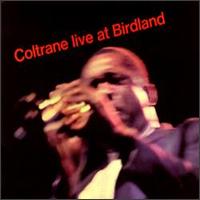 Live At Birdland (Mar - Nov 1963). Or, more precisely, three tracks recorded live at Birdland in October 1963 and three tracks recorded in-studio in March and November 1963. This is fantastic stuff, among the best of the albums with the classic quartet. The three live tracks are just brilliant, but the studio tracks include "Alabama," an elegy for the four little girls killed in the 16th Street Baptist Church bombing in Birmingham, AL. It is easily one of the most beautiful pieces of music ever recorded.
Live At Birdland (Mar - Nov 1963). Or, more precisely, three tracks recorded live at Birdland in October 1963 and three tracks recorded in-studio in March and November 1963. This is fantastic stuff, among the best of the albums with the classic quartet. The three live tracks are just brilliant, but the studio tracks include "Alabama," an elegy for the four little girls killed in the 16th Street Baptist Church bombing in Birmingham, AL. It is easily one of the most beautiful pieces of music ever recorded. Crescent (Apr - June 1964). Wikipedia notes that this is one of the darkest albums in Coltrane's catalog. Allmusic calls it meditative. I lean towards Allmusic's take: it seems meditative to me. The final track has Coltrane and Elvin Jones duetting on sax and drums, which is a sign of things to come.
Crescent (Apr - June 1964). Wikipedia notes that this is one of the darkest albums in Coltrane's catalog. Allmusic calls it meditative. I lean towards Allmusic's take: it seems meditative to me. The final track has Coltrane and Elvin Jones duetting on sax and drums, which is a sign of things to come. A Love Supreme (released Feb 1965, recorded Nov 1964). This is the peak: the greatest, most beautiful, most passionate, most amazing piece of music Coltrane ever made, and one of the greatest achievements of humanity. This is a single work in four parts, and while it is absolutely a work of jazz, it is most like the work of Bach. My version is the Deluxe Edition, which includes a live version of "A Love Supreme" recorded in Antibes in 1965, the only such live version of this piece.
A Love Supreme (released Feb 1965, recorded Nov 1964). This is the peak: the greatest, most beautiful, most passionate, most amazing piece of music Coltrane ever made, and one of the greatest achievements of humanity. This is a single work in four parts, and while it is absolutely a work of jazz, it is most like the work of Bach. My version is the Deluxe Edition, which includes a live version of "A Love Supreme" recorded in Antibes in 1965, the only such live version of this piece. The John Coltrane Quartet Plays (Feb - May 1965). It's unfortunate timing to follow the peak, but this album is crazy with brilliance. If A Love Supreme didn't exist, this would be the best of the quartet. Well, it would be tied with Live At Birdland. The choice of pop material ("Chim Chim Cheree" and "Nature Boy") hearkens back to My Favorite Things, but the constant search for transcendence in Coltrane's playing is purely of 1965.
The John Coltrane Quartet Plays (Feb - May 1965). It's unfortunate timing to follow the peak, but this album is crazy with brilliance. If A Love Supreme didn't exist, this would be the best of the quartet. Well, it would be tied with Live At Birdland. The choice of pop material ("Chim Chim Cheree" and "Nature Boy") hearkens back to My Favorite Things, but the constant search for transcendence in Coltrane's playing is purely of 1965. Ascension (June 1965). Coltrane added an extra bassist (Art Davis) and a bunch of horns for this (Pharoah Sanders, Freddie Hubbard, Archie Shepp, and three more). This is pretty much the turning point for Coltrane from modal Modern Jazz into free jazz. Like Ornette Coleman's Free Jazz album of 1960, Coltrane has assembled a crack team of young avant-garde musicians to realize a 40-minute piece of music. Unlike Free Jazz (although just different, not better), Coltrane is careful about assembling the soloists to build on a theme. The CD version, which I have, includes both 40-minute takes of "Ascension."
Ascension (June 1965). Coltrane added an extra bassist (Art Davis) and a bunch of horns for this (Pharoah Sanders, Freddie Hubbard, Archie Shepp, and three more). This is pretty much the turning point for Coltrane from modal Modern Jazz into free jazz. Like Ornette Coleman's Free Jazz album of 1960, Coltrane has assembled a crack team of young avant-garde musicians to realize a 40-minute piece of music. Unlike Free Jazz (although just different, not better), Coltrane is careful about assembling the soloists to build on a theme. The CD version, which I have, includes both 40-minute takes of "Ascension."Live In Antibes 1965 (July 1965). For some reason the track listing on my version is different from the one on Wikipedia. I have only the 45-minute version of "A Love Supreme" that is also on the A Love Supreme Deluxe release and a 20+ minute version of "Impressions." According to Wikipedia, instead of "A Love Supreme," I should have "Naima," "Blue Valse," and "My Favorite Things." Oh well. Both tracks on my version kick ass.
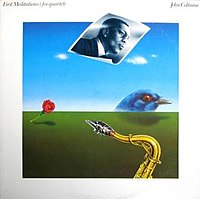 First Meditations (For Quartet) (recorded Sept 1965). Unreleased until 1977, this is the final recording of Coltrane's classic quartet without other accompaniment. Coltrane was unhappy with the sound of this album and later went back into the studio with Pharoah Sanders and Rashied Ali. But that story is below.
First Meditations (For Quartet) (recorded Sept 1965). Unreleased until 1977, this is the final recording of Coltrane's classic quartet without other accompaniment. Coltrane was unhappy with the sound of this album and later went back into the studio with Pharoah Sanders and Rashied Ali. But that story is below.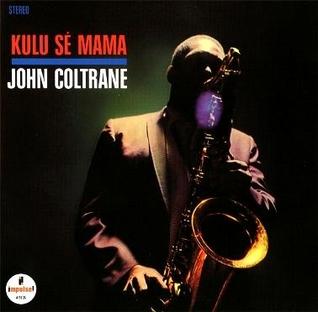 Kulu Se Mama (June - Oct 1965). The first and final three tracks feature an expanded band with Pharoah Sanders and several extra percussionists, including Juno Lewis, who wrote and chants on the title song. The second and third tracks feature the classic quartet doing some lovely classic quartet style music.
Kulu Se Mama (June - Oct 1965). The first and final three tracks feature an expanded band with Pharoah Sanders and several extra percussionists, including Juno Lewis, who wrote and chants on the title song. The second and third tracks feature the classic quartet doing some lovely classic quartet style music. Om (Oct 1965). Only one 30-minute track herein, with the classic quartet augmented by Pharoah Sanders plus bass clarinet plus flute. Sanders and Coltrane chant lines from the Tibetan Book of the Dead at the beginning and end of the track. In the middle is some pretty wild free-skronk blowing.
Om (Oct 1965). Only one 30-minute track herein, with the classic quartet augmented by Pharoah Sanders plus bass clarinet plus flute. Sanders and Coltrane chant lines from the Tibetan Book of the Dead at the beginning and end of the track. In the middle is some pretty wild free-skronk blowing. Meditations (released Sept 1966, recorded Nov 1965). Right, here's Meditations that I mentioned above. The classic quartet plus Rashied Ali on drums and Pharoah Sanders on sax. These are the same songs as they recorded on First Meditations, but the playing is more of the wild untethered and overblown sound of the late-period Coltrane. It was too much for Elvin Jones and McCoy Tyner, who left the quartet after this was recorded. It sounds pretty decent to my ears, though.
Meditations (released Sept 1966, recorded Nov 1965). Right, here's Meditations that I mentioned above. The classic quartet plus Rashied Ali on drums and Pharoah Sanders on sax. These are the same songs as they recorded on First Meditations, but the playing is more of the wild untethered and overblown sound of the late-period Coltrane. It was too much for Elvin Jones and McCoy Tyner, who left the quartet after this was recorded. It sounds pretty decent to my ears, though. Interstellar Space (Feb 1967). I should remedy my lack of post-quartet albums. I know that the Coltrane albums of 1966 and 1967 are special and mind-blowing, but I've never gotten around to most of them. This one is basically a conversation between Coltrane and Rashied Ali, with the results among the freest jazz Coltrane ever recorded. Lovely and skronky.
Interstellar Space (Feb 1967). I should remedy my lack of post-quartet albums. I know that the Coltrane albums of 1966 and 1967 are special and mind-blowing, but I've never gotten around to most of them. This one is basically a conversation between Coltrane and Rashied Ali, with the results among the freest jazz Coltrane ever recorded. Lovely and skronky.Retrospective: Impulse (released 1992). This is a three-disc box set that I got as a gift many years ago. It's a phenomenally bad idea, splitting Coltrane's Impluse! recordings up like a greatest hits collection. I've deleted the tracks I have elsewhere, and the remainder includes one from 1962's Ballads, two from 1962's Coltrane, one from 1965's Dear Old Stockholm (which I used to have but was stolen), one from 1965's Living Space, and one from 1967's Expression. All on my Amazon wish list! Amazon doesn't have Live In Japan, though, and that's one I feel I should hear. Ah, well. That one would have brought my Kurosawa comparison nicely full-circle. As is, I'm just going to have to leave off here.











2 comments:
You don't need Live in Japan, I don't think. I have about 40 Coltrane albums in my iPod and that 4CD set isn't among them. Two of the tracks - a version of "Crescent" and a version of "My Favorite Things" - are nearly an hour long each, and everything else is in the 20- to 30-minute range. But honestly, they don't stay fascinating for the whole running time. Each of the two longest cuts begins with a 15-minute or so Jimmy Garrison bass solo, and that's what I wind up listening to - when the whole band comes roaring in I'm usually only good for another 10-15 minutes.
Thanks, Phil! In my mind, Live In Japan has always been a heavily psychedelic precursor to Agharta or Pangaea. What should I get next?
Post a Comment